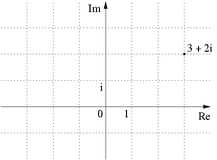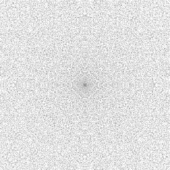- Gaussian integer
-
In number theory, a Gaussian integer is a complex number whose real and imaginary part are both integers. The Gaussian integers, with ordinary addition and multiplication of complex numbers, form an integral domain, usually written as Z[i]. The Gaussian integers are a special case of the quadratic integers. This domain does not have a total ordering that respects arithmetic.
 Gaussian integers as lattice points in the complex plane
Gaussian integers as lattice points in the complex plane
Formally, Gaussian integers are the set
Note that when they are considered within the complex plane the Gaussian integers may be seen to constitute the 2-dimensional integer lattice.
The norm of a Gaussian integer is the natural number defined as
(Where the overline over "a+bi" refers to the complex conjugate.)
The norm is multiplicative, i.e.
The units of Z[i] are therefore precisely those elements with norm 1, i.e. the elements
- 1, −1, i and −i.
Contents
As a unique factorization domain
The Gaussian integers form a unique factorization domain with units 1, −1, i, and −i. If x is a Gaussian integer, the four numbers x, ix, −x, and −ix are called the associates of x.
The prime elements of Z[i] are also known as Gaussian primes. An associate of a Gaussian prime is also a Gaussian prime. The Gaussian primes are symmetric about the real and imaginary axes. The positive integer Gaussian primes are the prime numbers congruent to 3 modulo 4, (sequence A002145 in OEIS). One should not refer to only these numbers as "the Gaussian primes", which term refers to all the Gaussian primes, many of which do not lie in Z. [1]
A Gaussian integer a + bi is a Gaussian prime if and only if either:
- one of a, b is zero and the other is a prime number of the form 4n + 3 (with n a nonnegative integer) or its negative − (4n + 3), or
- both are nonzero and a2 + b2 is a prime number (which will not be of the form 4n + 3).
The following elaborates on these conditions.
2 is a special case (in the language of algebraic number theory, 2 is the only ramified prime in Z[i]).
The integer 2 factors as 2 = (1 + i)(1 − i) = i(1 − i)2 as a Gaussian integer, the second factorisation (in which i is a unit) showing that 2 is divisible by the square of a Gaussian prime; it is the unique prime number with this property.
The necessary conditions can be stated as following: if a Gaussian integer is a Gaussian prime, then either its norm is a prime number, or its norm is a square of a prime number. This is because for any Gaussian integer g, notice
 .
.
Here
 means “divides”; that is,
means “divides”; that is,  if x is a divisor of y.
if x is a divisor of y.Now N(g) is an integer, and so can be factored as a product
 of prime numbers, by the fundamental theorem of arithmetic. By definition of prime element, if g is a Gaussian prime, then it divides (in Z[i]) some pi. Also,
of prime numbers, by the fundamental theorem of arithmetic. By definition of prime element, if g is a Gaussian prime, then it divides (in Z[i]) some pi. Also,  divides
divides , so
, so  in Z.
in Z.
This gives only two options: either the norm of g is a prime number, or the square of a prime number.
If in fact N(g) = p2 for some prime number p, then both g and
 divide p2. Neither can be a unit, and so
divide p2. Neither can be a unit, and so- g = pu and

where u is a unit. This is to say that either a = 0 or b = 0, where g = a + bi.
However, not every prime number p is a Gaussian prime. 2 is not because 2 = (1 + i)(1 − i). Neither are prime numbers of the form 4n + 1 because Fermat's theorem on sums of two squares assures us they can be written a2 + b2 for integers a and b, and a2 + b2 = (a + bi)(a − bi). The only type of prime numbers remaining are of the form 4n + 3.
Prime numbers of the form 4n + 3 are also Gaussian primes. For suppose g = p + 0i for p = 4n + 3, and it can be factored g = hk. Then p2 = N(g) = N(h)N(k). If the factorization is non-trivial, then N(h) = N(k) = p. But no sum of squares of integers can be written 4n + 3. So the factorization must have been trivial and g is a Gaussian prime.
If g is a Gaussian integer whose norm is a prime number, then g is a Gaussian prime, because the norm is multiplicative.
As an integral closure
The ring of Gaussian integers is the integral closure of Z in the field of Gaussian rationals Q(i) consisting of the complex numbers whose real and imaginary part are both rational.
As a Euclidean domain
It is easy to see graphically that every complex number is within
 units of a Gaussian integer.
units of a Gaussian integer.Put another way, every complex number (and hence every Gaussian integer) has a maximal distance of
units to some multiple of z, where z is any Gaussian integer; this turns Z[i] into a Euclidean domain, where
 .
.
Historical background
The ring of Gaussian integers was introduced by Carl Friedrich Gauss in his second monograph on quartic reciprocity (1832) (see [2]). The theorem of quadratic reciprocity (which he had first succeeded in proving in 1796) relates the solvability of the congruence x2 ≡ q (mod p) to that of x2 ≡ p (mod q). Similarly, cubic reciprocity relates the solvability of x3 ≡ q (mod p) to that of x3 ≡ p (mod q), and biquadratic (or quartic) reciprocity is a relation between x4 ≡ q (mod p) and x4 ≡ p (mod q). Gauss discovered that the law of biquadratic reciprocity and its supplements were more easily stated and proved as statements about "whole complex numbers" (i.e. the Gaussian integers) than they are as statements about ordinary whole numbers (i.e. the integers).
In a footnote he notes that the Eisenstein integers are the natural domain for stating and proving results on cubic reciprocity and indicates that similar extensions of the integers are the appropriate domains for studying higher reciprocity laws.
This paper not only introduced the Gaussian integers and proved they are a unique factorization domain, it also introduced the terms norm, unit, primary, and associate, which are now standard in algebraic number theory.
Unsolved problems
Gauss's circle problem does not deal with the Gaussian integers per se, but instead asks for the number of lattice points inside a circle of a given radius centered at the origin. This is equivalent to determining the number of Gaussian integers with norm less than a given value.
There are also conjectures and unsolved problems about the Gaussian primes. Two of them are:
The real and imaginary axes have the infinite set of Gaussian primes 3, 7, 11, 19, ... and their associates. Are there any other lines that have infinitely many Gaussian primes on them? In particular, are there infinitely many Gaussian primes of the form 1+ki?[2]
Is it possible to walk to infinity using the Gaussian primes as stepping stones and taking steps of bounded length?[3] More generally, is there a constant B such that the set of Gaussian primes is connected by edges of length at most B, or stated differently, such that for every two Gaussian primes p and q, the minimax path in the Gaussian primes between p and q (the path minimizing the length of its longest edge) has every edge length at most B? The latter statement is slightly stronger than the one about walking to infinity, as it also excludes remote "islands" of Gaussian primes, separated from all others by arbitrarily wide "moats" of Gaussian non-primes.
See also
- Hurwitz quaternion
- Eisenstein integer
- Dirichlet integer (in French)
- Quadratic integer
- Algebraic integer
- Proofs of Fermat's theorem on sums of two squares
- Proofs of quadratic reciprocity
- Splitting of prime ideals in Galois extensions describes the structure of prime ideals in the Gaussian integers
- Table of Gaussian integer factorizations
Notes
References
- C. F. Gauss, Theoria residuorum biquadraticorum. Commentatio secunda., Comm. Soc. Reg. Sci. Gottingen 7 (1832) 1-34; reprinted in Werke, Georg Olms Verlag, Hildesheim, 1973, pp. 93-148.
- Kleiner, Israel (1998). "From Numbers to Rings: The Early History of Ring Theory". Elem. Math. 53 (1). doi:10.1007/s000170050029. http://www.ems-ph.org/journals/show_pdf.php?issn=0013-6018&vol=53&iss=1&rank=2.
- Ribenboim, Paulo (1996). The New Book of Prime Number Records. New York: Springer. ISBN 0-387-94457-5.
External links
- www.alpertron.com.ar/GAUSSIAN.HTM is a Java applet that evaluates expressions containing Gaussian integers and factors them into Gaussian primes.
- www.alpertron.com.ar/GAUSSPR.HTM is a Java applet that features a graphical view of Gaussian primes.
- Henry G. Baker (1993) Complex Gaussian Integers for 'Gaussian Graphics', ACM SIGPLAN Notices, Vol. 28, Issue 11. DOI 10.1145/165564.165571 (html)
- IMO Compendium text on quadratic extensions and Gaussian Integers in problem solving
- Weisstein, Eric W., "Moat-Crossing Problem" from MathWorld.
- Gethner, Ellen; Wagon, Stan; Wick, Brian (April 1998). "A Stroll Through the Gaussian Primes". American Mathematical Monthly 105 (4): 327–337. doi:10.2307/2589708. JSTOR 2589708. http://www.joma.org/images/upload_library/22/Chauvenet/GethnerWagonWick.pdf.
- Weisstein, Eric W., "Landau's Problems" from MathWorld.
Categories:- Cyclotomic fields
- Algebraic numbers
- Lattice points
Wikimedia Foundation. 2010.

![\mathbb{Z}[i]=\{a+bi \mid a,b\in \mathbb{Z} \}.](5/2b52d37c82197a826da85e4a9527cdf5.png)



